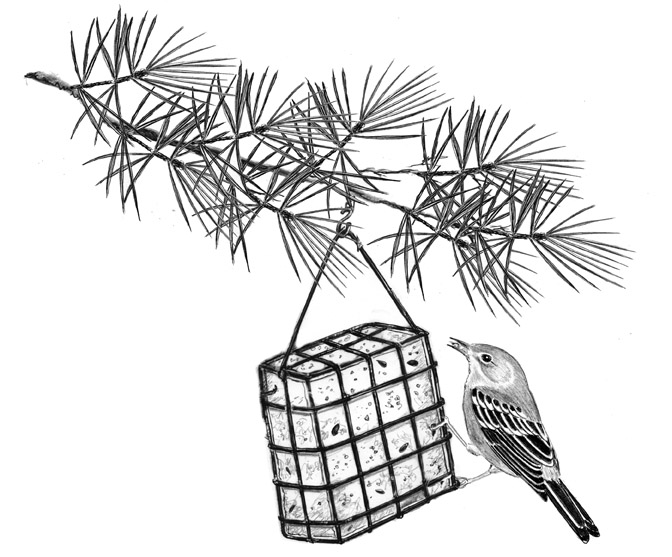
Dear Bird Folks,
Here is a photo of the bird we discussed this morning in your parking lot. It’s been coming to my feeder for the last few days. Please let me know what it is.
– Phil, Wellfleet, MA
You got it, Phil,
I’ll let you know about your bird in a minute, but first I went to tell everyone else about what we “discussed” in my parking lot. Because of the dreadful virus we are dealing with right now, all conversations have to be held from a distance. Phil, while leaning out of his car window, asked me about a “chartreuse-colored finch” that was coming to his feeder. From across the lot I shouted that I didn’t know what color chartreuse was. After a brief pause, Phil yelled back that he also didn’t know. What? I next asked him to simply describe the bird’s color to me. He couldn’t do that either. Why not? Because Phil is…wait for it, “colorblind.” Again, what? It turns out the whole chartreuse narrative was his wife’s idea. Phil was just the middleman. I finally told him to go home and send me a photo of the bird. Meanwhile, I went back inside to look up chartreuse.
I asked everyone at work if they knew what color chartreuse (shar-troos) was, and no one, including our resident artist, and illustrator of the above image, knew the answer. Most of us voted for a shade of pink and we were all wrong. Chartreuse, they say, is green/yellow (half green and half yellow). Okay, but why the odd name? Why not just call it “grellow” or “yeen”? Further research tells us that chartreuse is named after a similarly colored French liqueur. How about that? I guess I have to hire more people with a French background, or at least a few more heavy drinkers. Regardless, from the moment we cracked the color code, I knew the ID of the unknown bird, and Phil’s photos eventually confirmed it. It was a Pine Warbler. There you have it. Another mystery solved by CSI: Chartreuse.
Phil’s wife is totally right; Pine Warblers are indeed green/yellow and are one of the few warblers that can be described as a “feeder bird.” While many of our favorite birds are in serious decline, the population of Pine Warblers actually seems to be on the increase and for years the best place to look for these grellow birds has been right here on Cape Cod. Why do they like the Cape, you ask? Are they fond of cranberries or sand? No, but there is something else they like. Wanna know what it is? I’ll give you a hint: It’s part of their name. Pine Warblers love pine trees. And what does Cape Cod have plenty of? We have lots and lots of good old pine trees, pitch pines to be exact. Pitch pines aren’t especially good for lumber or firewood, or much else, but don’t tell the warblers that. They can’t get enough of them.
Most other warbler species leave North America in the winter and journey south to bask in the warm sun of the tropics, but Pine Warblers are short-distance migrants. Some remain here on the Cape, but most head to the Southern states, especially the Carolinas, where there’s also lots of pine trees. Often, the migrants from the North and the local Carolina birds meet up and join together to form large flocks. It’s nice that at least the North and South birds can get along.
Traditionally, warblers are insect eaters, which is the main reason they leave when things get cold. But Pine Warblers are flexible. If they can’t find insects, they’ll switch to plan B…seeds. In fact, they are one of the few warblers that are able to digest seeds. What kind of seeds do they eat? Pine seeds, of course. Did you really have to ask? They’ll also take hulled sunflower and bits of suet from our feeders. Eating seeds in the winter seems like an obvious choice for the birds, but warblers are built for gleaning tiny insects from tree branches. Dealing with tough seeds requires a few adaptations. It is thought the Pine Warbler’s digestive system actually changes in the winter in order to process their new diet. Then there is the problem of opening the seeds. The beaks of finches, sparrows and other seed-eating birds can easily crack open whatever seeds are on the menu, but warblers aren’t so lucky. Their thin beaks are designed for soft bugs. In order to beat the system, the resourceful Pine Warblers jam the seeds into bark crevices and hammer them open, nuthatch-style.
In addition to being chartreuse, Pine Warblers have two other important field marks – white wing-bars and split eye-rings. These features can be helpful when identifying young birds or duller females (or if you happen to be colorblind). Male Pine Warblers are chatty birds and can be heard singing anytime of year, but really crank things up in the spring. Their song is a rather uncreative buzzy trill. Some birders confuse this trill with that of the similar sounding Chipping Sparrow. For years, I too struggled to differentiate between the two birds, but that is no longer a problem for me. I can’t hear either bird anymore. (Oh well, one less thing to deal with.) Tell your wife to enjoy her chartreuse “finch,” Phil. I’m only sorry you can’t appreciate its beauty. But listen for its song. If you hear a buzzy trill, it’s a Pine Warbler…or maybe a Chipping Sparrow. Who knows? One more suggestion: The next time you are having a game of Scrabble and need a good word, try playing either grellow or yeen. Neither word might be in the dictionary, but they should be.